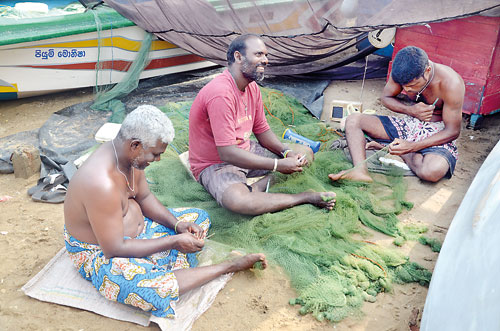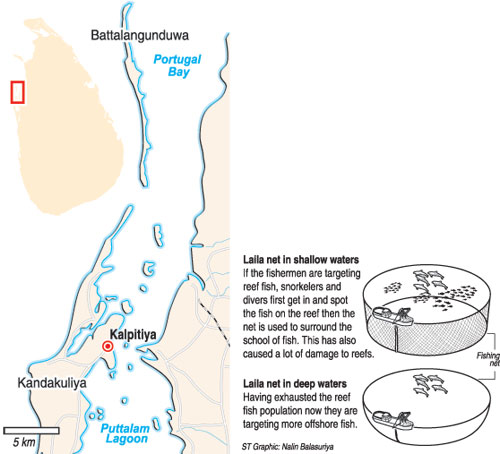News
Fishing: Catch and with what
View(s):Small scale operators say unfair methods affecting their livelihood
By S. Rubatheesan
The Fisheries Ministry has decided to introduce new regulatory mechanisms for fishing methods and fishing gear when issuing permits for fishing in the aftermath of violent clashes between fishermen’s groups in Kalpitiya last week, a senior Ministry official said.

Fishermen with their nets. Pic by Augustin Fernando
“Following a meeting with representatives of two rival groups, Minister Mahinda Amaraweera directed us to bring in amendments to the existing regulations to sort this matter out with concerned parties,” Director General M.C.L.Fernando who is responsible for issuing fishing licences told the Sunday Times.
Last week, two factions of fisher folk employing different fishing methods took to the streets bringing traffic on the Puttalam- Kalpitiya road to a standstill.
The verbal agitation developed into a violent clash between the two groups, with a lorryload of fish being transported set on fire along with five motor cycles. After the violence was brought under control with the deployment of the Special Task Force (STF) and police, a group of fishermen set on fire five fishing boats moored on the shore at Kalpitiya.
Fishermen carrying out their operations on a small scale alleged that the use of illegal fishing methods such as ‘hambili’, ‘laila’, and ‘surukku’ by another group of fishermen operating on a large scale affected their livelihood significantly with their catch reduced considerably.
However Mr. Fernando ruled out the claim that the ‘hambili’ net which is widely used by the fishermen in the Kalpitiya area is illegal. “It is a very productive fishing method and we have issued 53 licences to Kalpitiya fishermen and issued more than 200 permits to fishermen on the Eastern coast,” he said.
In 2015 the Fisheries Ministry had banned the practice of all purse seine fishing methods but later permits were issued with a slight modification of nets after strong protests from the fisher community. Later on the fishermen went to the Supreme Court and got a positive verdict directing the Minister and the Director General to issue renewable permits for fishermen.
 “Since a 1987 gazetted regulation legalised such fishing, I had to withdraw my circular banning them. The new amendments will be focusing on regulating this issue,” he said.
“Since a 1987 gazetted regulation legalised such fishing, I had to withdraw my circular banning them. The new amendments will be focusing on regulating this issue,” he said.
The rival group claimed that the use of laila and surukku fishing nets would destroy the rich marine resources in the deep sea while also posing a threat to the mangrove environment.
Fishermen who engage in the ‘hambili’ fishing method argued that their mode of fishing is not banned by the Fisheries Ministry as the Fisheries Department which is tasked to issue licences to local fishermen issued 53 such fishing permits to them this year alone.
The ‘hambili’ fishing method which comes under purse seine fishing uses a large wall of netting deployed around an entire area or school of fish. When a school of fish is located, a skiff encircles the school with the net. The lead line which is floating on the surface is then pulled in, “pursing” the net closed , preventing fish from escaping by swimming downwards.
Anton Dias, President of Our Lady of Sorrows Rural Society, a fishing village in Battalangunduwa countered the allegations of illegal fishing saying that the nets used by them are modified as instructed when fishing permits were issued.
“Earlier the size of the net gun was one and half inches. After research studies done by the ministry, we were instructed to increase the size of the eye of the net to two and half inches to avoid small fish types getting caught,” he told the Sunday Times.
At least 423 boats are engaged in fishing using ‘hambili’ nets roughly 25 metres long and 225 metres wide with a net gun size of two and half inches.
Fishermen’s leader Dias also alleged that fishermen from Chilaw, Negombo, and Talawila come to the Kalpitiya sea for fishing and are supporting the small scale fishermen to protest against them.
Meanwhile the small scale fishermen alleged that fishermen who use the ‘hambili’ net wiped out the entire catch before it reached its allocated region – ten kilometres from the shore. Last year the National Aquatic Resources Research and Development Agency (NARA), the research arm of the ministry recommended the ministry ban all harmful methods of purse seine fishing and remedial methods proposed.
A comprehensive report finalised by then head of the marine research division Dr.R.R.P.Maldeniya noted how the rich marine resources in the Kalpitiya lagoon have been exploited by fishermen with harmful fishing methods.
“Since our fishing resources are limited around the island, there should be effective fishing methods in place to protect the marine life species and its diversity in the sea,” the report noted.
| More regulations to stop use of illegal fishing nets The government will introduce more regulations to crack down on the use of illegal fishing nets, Fisheries Minister Mahinda Amaraweera said yesterday. He said the universities of Ruhuna and Wayamba have been tasked with providing a scientific report on the damage caused to marine resources by the fishing nets that are currently used before the regulations are formulated. He said as an immediate measure officials from the National Acquatic Resources Agency, Fisheries Department officials supported by the Navy in the Kalpitiya area have been deployed to ensure that dynamite is not being used to catch fish. | |

